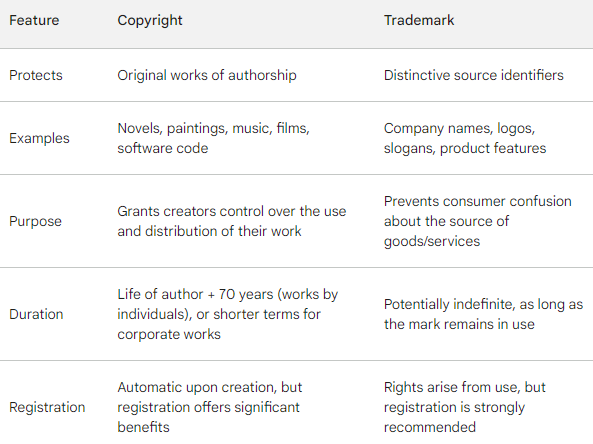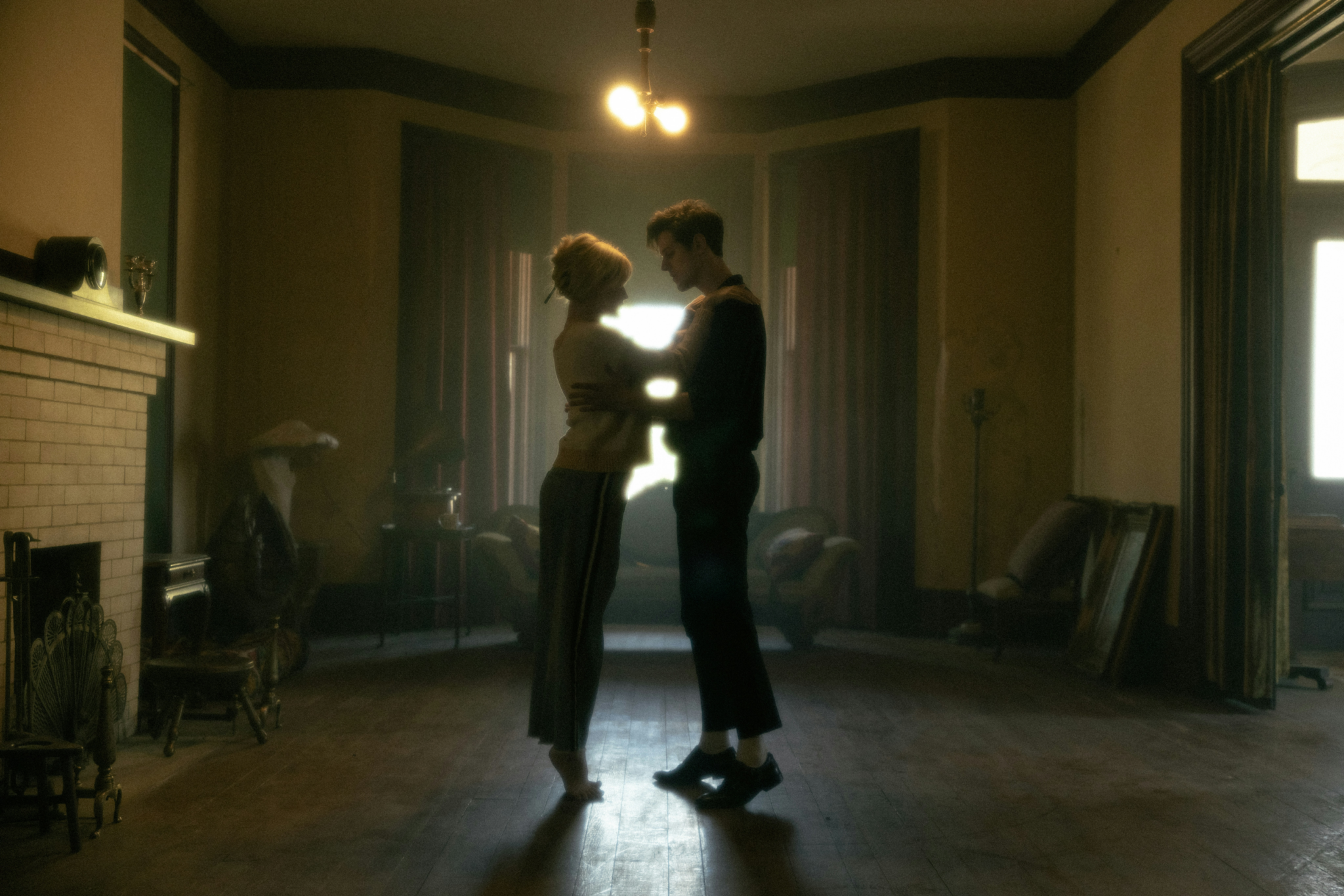Understanding the distinction between copyright and trademark is vital for businesses, creators, and anyone with valuable intellectual property (IP). Both copyright and trademark offer legal protection, but they safeguard different types of assets. This article will delve into the key differences, provide examples, and explain how to choose the right protection for your work.

What is Copyright?
Definition: Copyright protects original works of authorship that are fixed in a tangible form. This means the work must be expressed in a way that can be perceived, either directly or through the use of a device.
Types of works protected:
Literary works (books, articles, poems, website content, code)
Musical compositions (songs, instrumental pieces, sound recordings)
Dramatic works (plays, scripts, screenplays)
Choreographic works (dance routines)
Pictorial, graphic, and sculptural works (paintings, photographs, sculptures, illustrations)
Motion pictures and other audiovisual works (films, videos, online content)
Sound recordings
Architectural works
Rights granted: Copyright gives the copyright owner exclusive rights to:
Reproduce the work (make copies)
Prepare derivative works (create adaptations, translations, or modifications )
Distribute copies of the work (sell, rent, lend)
Perform the work publicly (plays, music, film screenings)
Display the work publicly (artwork, online content)
Requirements for Copyright

Originality: To be protected, the work must be independently created and demonstrate some element of creativity.
Fixation: The work needs to exist in a tangible form, not just an idea in your head. This can be digital or physical.
Originality is a cornerstone of copyright protection. However, it carries a nuanced meaning within the legal framework:
Not About Novelty: Copyright doesn’t require your work to be the first of its kind or completely groundbreaking. Two artists could independently create similar paintings inspired by the same sunset, and both might qualify for copyright protection.
Independent Creation Matters: The key is that you brought the creative work into existence through your own efforts, not by copying someone else’s creation.
A Touch of Creativity: While there’s some debate about the degree, copyright does require a minimal level of creativity. Simple lists, facts, or phonebook-style entries don’t usually qualify. Think about adding your unique expression, a spark of your perspective, or a creative arrangement.
The Sweat of the Brow vs. Artistic Merit: Early copyright concepts favored a “sweat of the brow” doctrine – if you put in hard work, you deserve protection. Nowadays, the focus is more on a modicum of creativity, not just effort. Your work doesn’t need to be a masterpiece to be original.
Why is this important?
Prevents Plagiarism: Originality encourages people to generate their own ideas for the benefit of society.
Rewards Independent Effort: It helps ensure creators receive recognition and potential financial benefit for their original contributions.
It’s a fascinating topic with ongoing debate and interpretation. Courts often face difficult judgment calls when deciding if a work is sufficiently original to deserve copyright protection.
How to obtain copyright
Copyright protection arises automatically the moment an original work is fixed in a tangible form. However, formal copyright registration with the U.S. Copyright Office is strongly advised as it provides significant legal advantages:
It’s a prerequisite for filing an infringement lawsuit.
It provides evidence of ownership in legal disputes.
It allows for the recovery of statutory damages and attorney’s fees in successful infringement cases.
What is a Trademark?
Definition: A trademark is any word, phrase, symbol, design, or combination thereof that distinguishes the goods or services of one business from those of others.
Types of trademarks:
Brand names (e.g., Apple, Starbucks)
Logos (e.g., Nike’s swoosh, McDonald’s golden arches)
Slogans (e.g., “Think Different”, “I’m lovin’ it”)
Product shapes and packaging (e.g., the unique Coca-Cola bottle, Tiffany’s blue box)
Sounds (e.g., MGM’s lion roar)
Colors (e.g., Owens Corning’s pink insulation)
Scents (although less common and subject to specific requirements)
Rights granted: Trademarks prevent others from using confusingly similar marks that might cause consumers to mistakenly believe goods or services originate from the same source.
How to obtain a trademark: Trademark rights generally arise from the use of the mark in commerce. However, similar to official copyright registration, registering your trademark with the U.S. Patent and Trademark Office (USPTO) offers a host of advantages:
Provides nationwide constructive notice of ownership.
Gives you the right to use the ® symbol.
Grants strong presumptions of ownership and validity in court.
Allows for filing with U.S. Customs to block infringing imports.
Copyright vs. Trademark: Key Differences

Let’s illustrate the concept of how copyrights protect creative works:
Real-World Examples
Book: The text of a novel is protected by copyright law. The book’s title and the publishing house’s logo may be trademarked.
Song: The musical composition, lyrics, and sound recording are protected by copyright law. The artist’s or band’s name, album title, and album cover art could all be trademarked.
Movie: The script, visual elements, soundtrack, and overall film are protected by copyright intellectual property protection. The movie title, the studio’s logo, iconic character names or phrases, and merchandise based on the movie might be subject to trademarks.
Software: The underlying code is protected by copyright. The software’s name, company logo, distinctive user interface elements, and product packaging design may all be trademarked.
Website: The website’s text, images, videos, and code are generally copyrightable. The business name, logo, domain name, and specific design features could be trademarks.
When Copyright and Trademark Overlap
It’s crucial to remember that some forms of intellectual property can fall under both copyright and trademark protection. Here are common examples:
Artwork in a logo: The artwork itself enjoys copyright protection. Its use as a company’s identifying logo also makes it eligible for federal trademark registration and protection.
Character names and catchphrases: Fictional character names and their iconic phrases, while primarily part of a larger copyrighted work (book, movie), might be trademarked on merchandise to prevent unauthorized use.
Jingles and musical themes: Short, memorable musical pieces used in advertising or as recurring themes can be both copyrighted as compositions and trademarked as identifiers of a brand.
Website Design: While the underlying code and content of a website are copyrighted, the overall look and feel, including layout, color scheme, and distinctive graphics, could potentially function as a trademark if they strongly identify the source of the website’s services.
Case Law

The case Rogers v. Grimaldi demonstrates the differences between trademarks and copyrights.
In 1989, a film titled “Ginger and Fred” was released. The film was a fictionalized account of two Italian dancers whose stage names and whose act were inspired by the legendary duo Ginger Rogers and Fred Astaire.
Ginger Rogers, a famous actress, sued the film’s producers, alleging both copyright infringement and trademark violations under the Lanham Act. She argued the film used her identity and created a false connection to the film.
The Arguments & Outcomes
Trademark
Ginger Rogers claimed the film’s title and promotional materials were misleading by using her recognizable name, creating an impression she endorsed the film. The court agreed, finding a likelihood of consumer confusion.
Copyright
While copyright law can apply to certain characters or artistic works, Rogers had a weaker case here. The film was deemed a fictionalized tribute, not a direct copying of her artistic works.
First Amendment
The court acknowledged the need for artistic expression and weighed this against the harm done under the Lanham Act (the trademark act). Ultimately, while the film did have expressive elements, the use of Rogers’ name without consent tilted the decision in her favor.
Why This Case is Significant
It demonstrates that even artistic creations with First Amendment protection aren’t immune to trademark infringement, particularly when:
Commercial Benefit: The film was released for profit, weakening arguments around protected free speech.
Likelihood of Confusion: The court deemed the film’s title and marketing created a false association in consumers’ minds.
Balancing Act: The decision highlights the constant tension between artistic expression, free speech, and the right of individuals to control how their names and personas are used commercially.
Choosing the Right Protection: Key Considerations
Deciding on the most appropriate protection for your intellectual property can sometimes be a nuanced process. Here’s a simplified guide:
If your focus is on original, creative works of expression: Copyright is likely the best fit. This includes literary works, music, art, software, etc.
If you need to protect your brand identity and identifiers from unauthorized use: Trademark is your primary tool. Consider this for your company name, logos, product names, and slogans.
Unsure or both might apply: Always consult with a qualified intellectual property attorney. They will assess your specific situation and help you develop a comprehensive protection strategy.
Important Notes
International Considerations: While this article focuses on U.S. law, copyright protections and trademark protections have international dimensions. Many countries have similar IP laws based on treaties and agreements, but specific procedures might vary.
The Power of Registration: As emphasized earlier, formally registering both copyrights and trademarks provides substantial legal advantages. Don’t overlook this important step.
Evolving Landscape: Intellectual property law is constantly adapting to new technologies and business practices. It’s wise to stay informed or seek professional advice when dealing with cutting-edge issues.
Resource: Consult with the trademark office for important guidance regarding legal protections related to trademarks. The copyright office also has guides, which are referred to as circulars.
